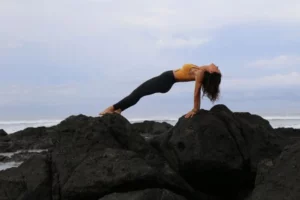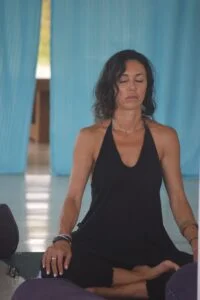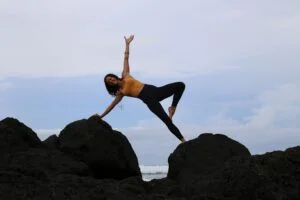By Christina Hennelly
When it comes to teaching yoga, being in the teacher’s seat isn’t always all sunshine and rainbows. Human beings are complicated and when you add a mild traumatic brain injury (mTBI) in the mix, you can expect to see some classes that will take their toll on you. More and more studies reveal that an adaptive yoga for TBI can be very advantageous and an increasing number of medical doctors are prescribing yoga as part of a patient’s recovery plan. This is all great news, but it can be very hard for any teacher to understand where to start with this population. With some thoughtful and creative considerations about brain injuries, you can hold safe space for your students while they regain their confidence in their recovery process. Here are some useful tips and considerations.

Mindfulness of head movement in yoga for TBI
The first thing to consider for your students when teaching yoga for TBI is that any position in which they move their head too fast, up or down, or side to side, can cause an array of symptoms. Turning over unto one’s side, getting up to a seated position and moving up to standing are all times during your class that you will need to take extra caution. Be aware of any balance issues from your students when they enter the room and get settled into your class. Keep an eye on these individuals. Make frequent reminders to go slowly and gently throughout your class and to take as many breaks as they feel necessary.
It is advisable to avoid downward dogs and forward folds until you are more comfortable with your student’s injuries. Use wall space for all standing balancing poses and offer several bus stops for each transition of poses, and have blocks, blankets and straps readily available as well. This will give your students more confidence in their practice and keep them coming back to glean the benefits of your classes. Don’t forget to have everyone sign a release form prior to class confirming they have been given the green light from their physicians to be in attendance.
Triggers in Yoga for TBI
Secondly, it’s important to consider any potential triggers in teaching yoga for TBI. You may be familiar with certain triggers that you should avoid for a post traumatic stress or anxiety population, but what about triggers for mTBI survivors? There are a plethora of brain injury symptoms and every mTBI survivor has different prompts for each indicator. Headaches, panic attacks, ringing in the ears, confusion, emotional outbursts, sudden and extreme fatigue are just a few of the common events that could result from a trigger. Examine your space. Is the lighting bright enough for people to find their way to and from their mat but not so bright that it’s causing people a sudden headache?
Avoid florescent lighting and opt for a red light or salt lamp. People with mTBIs can have major light sensitivity. You may notice some of your students wearing large dark glasses or even two pairs of glasses. Don’t worry, they can still see you through these dark lenses. When it comes to music, no music is best. Any noises at all other than your teaching voice can be very distracting for this population and frustrating for them if they have hearing problems. Speak loudly and clearly and use simple, direct cues. Avoid using Sanskrit words for poses since this could be extremely confusing and offer demonstrations throughout the class. Invite caregivers to join in and remind everyone that there are no expectations other than to have fun.

Breathwork for TBI
Next, let’s look at breath in yoga for TBI. Deep breathing techniques increases the supply of oxygen to the brain thereby stimulating the parasympathetic nervous system. This redirection of focus to the breath during yoga practice naturally moves one’s mind away from present thoughts and onto one’s breathing, connecting the mind and body.
“The ancient yogic science of breath is the science that deals with body, breath, mind, soul, and ultimately, the universe itself. Just as a thread links the kite-flier to his kite, breath is said to link the mind with the universal force. Medical science is currently rediscovering and validating many of the ancient health practices from traditional cultures worldwide.” (Zope & Zope, 2013)
Shallow, short breaths can increase anxiety making you feel like your suffocating or hungry for air. In fact studies have shown a strong association between anxiety and shortness of breath. Share these interesting facts with your students during pranayama. This will instill the habit of the connection to breath throughout their day. Note that any breaths of fire or inhalations that are longer than exhalations may be too stimulating. They can cause dizziness or an overall feeling of uneasiness. Stay with long, 3-part breaths and belly breath work. Left nostril breathing with the right nostril blocked, is also very useful for calming and relaxing. Humming bee breath can also be appropriately settling, quieting the mind and reducing negative feelings like agitation and apprehension.

Ending your Practice/Class for Yoga for TBI
Lastly, we will consider using 2-4 restorative poses coupled with meditation as a seamless ending to your class. Focus on light and upbeat themes that are motivational and transformative. Keep in mind that many mTBI survivors are also struggling with mental health issues. This is as a result of the significant changes to their lives. So invite them to let go of their day, whatever may not be serving them. Teach them to replace that with positivity and an intention of kindness towards themselves. Provide them the tools to navigate and start to manage their thoughts. Give them calming, pleasant stories and invite them to a place of ease and comfort (Sengupta, 2012).
Perhaps one simple loving word or the Mantra “HUMSA.” When repeated over and over during the restorative poses it will be just what they need. Use a grounding Mudra for their hands like fingers gently wrapped around each thumb. Another to try is touching pinky fingers to thumbs to reduce anxiety. Regular meditation is a powerful instrument in rehabilitation work.
Adaptive yoga is a valuable tool for people recovering from mTBI. It creates a sense of community, increases self-esteem and stimulates hope and motivation. Working with this population can have its challenges but being a witness to their journey is priceless.
About the Author

Christina Hennelly is a Graduate of Soma Yoga Institutes 200-Hour Therapeutic Yoga Teacher Training and a neurorehabilitation therapist.